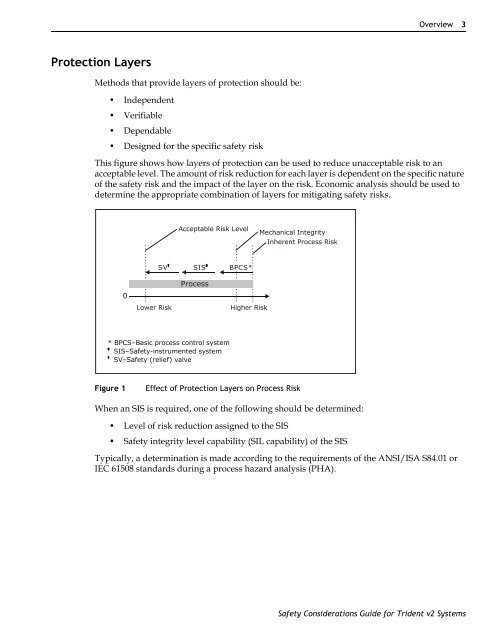Safety Considerations Guide for Trident v2 Systems - TUV ...
Safety Considerations Guide for Trident v2 Systems - TUV ...
Safety Considerations Guide for Trident v2 Systems - TUV ...
Create successful ePaper yourself
Turn your PDF publications into a flip-book with our unique Google optimized e-Paper software.
Protection Layers<br />
Methods that provide layers of protection should be:<br />
• Independent<br />
• Verifiable<br />
• Dependable<br />
• Designed <strong>for</strong> the specific safety risk<br />
Overview 3<br />
This figure shows how layers of protection can be used to reduce unacceptable risk to an<br />
acceptable level. The amount of risk reduction <strong>for</strong> each layer is dependent on the specific nature<br />
of the safety risk and the impact of the layer on the risk. Economic analysis should be used to<br />
determine the appropriate combination of layers <strong>for</strong> mitigating safety risks.<br />
0<br />
SV<br />
Acceptable Risk Level<br />
SIS<br />
Process<br />
Lower Risk Higher Risk<br />
* BPCS–Basic process control system<br />
SIS–<strong>Safety</strong>-instrumented system<br />
SV–<strong>Safety</strong> (relief) valve<br />
BPCS*<br />
Mechanical Integrity<br />
Inherent Process Risk<br />
Figure 1 Effect of Protection Layers on Process Risk<br />
When an SIS is required, one of the following should be determined:<br />
• Level of risk reduction assigned to the SIS<br />
• <strong>Safety</strong> integrity level capability (SIL capability) of the SIS<br />
Typically, a determination is made according to the requirements of the ANSI/ISA S84.01 or<br />
IEC 61508 standards during a process hazard analysis (PHA).<br />
<strong>Safety</strong> <strong>Considerations</strong> <strong>Guide</strong> <strong>for</strong> <strong>Trident</strong> <strong>v2</strong> <strong>Systems</strong>
















